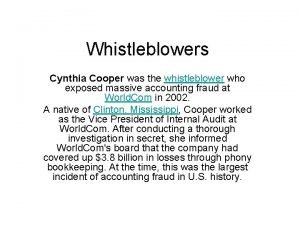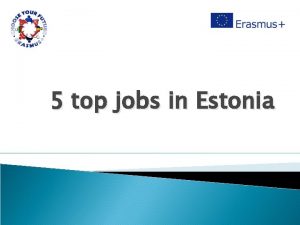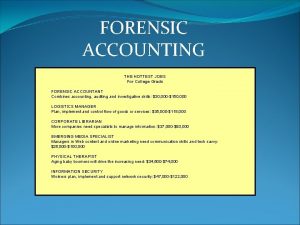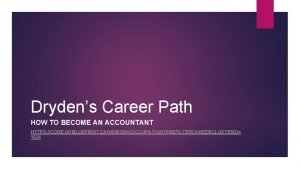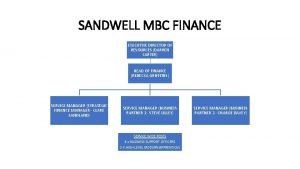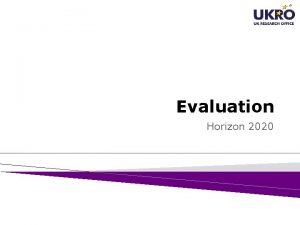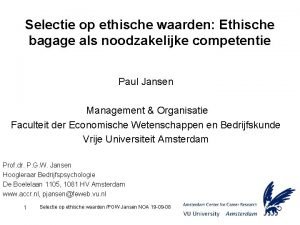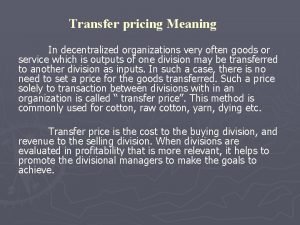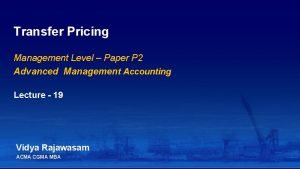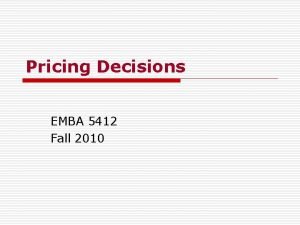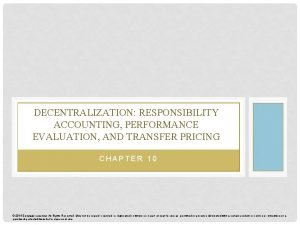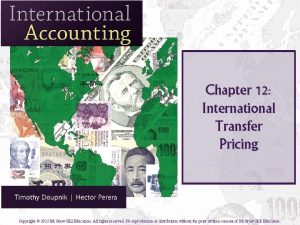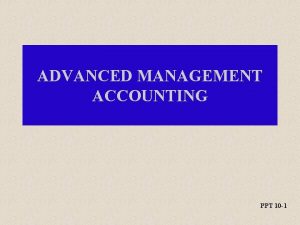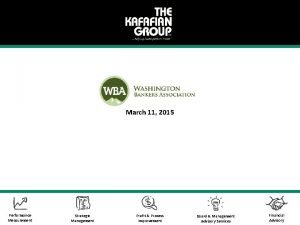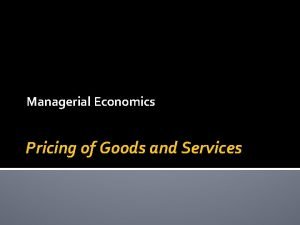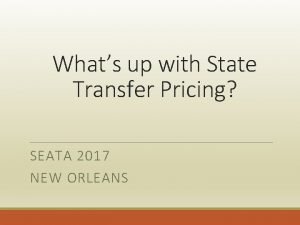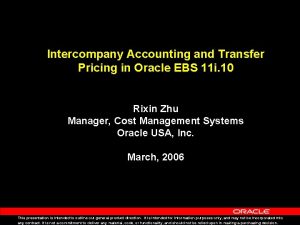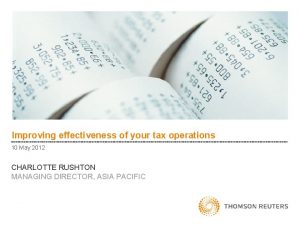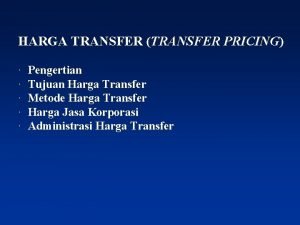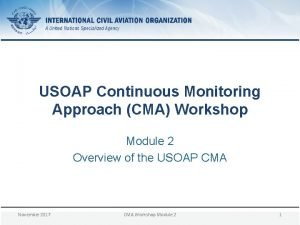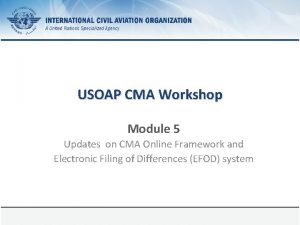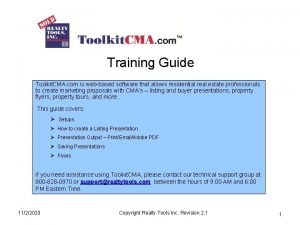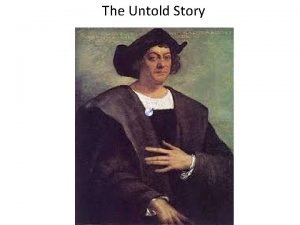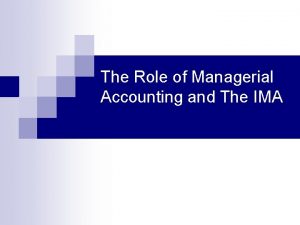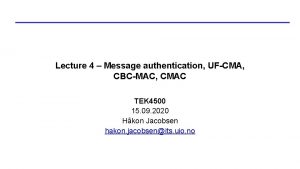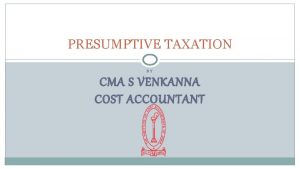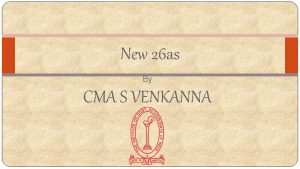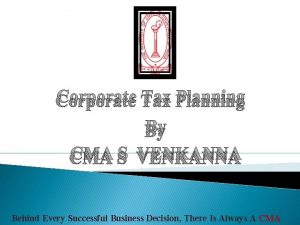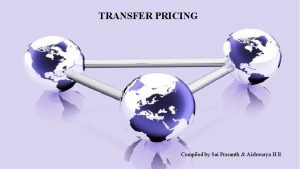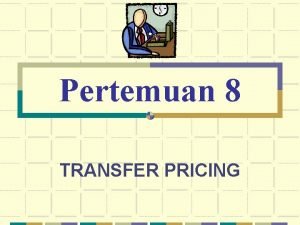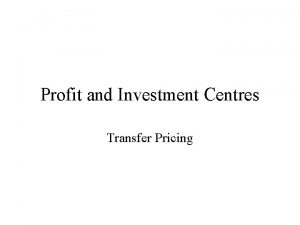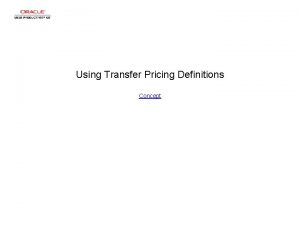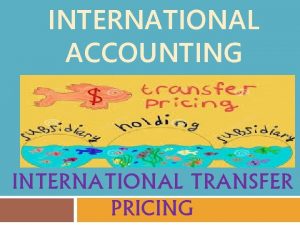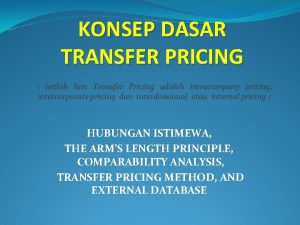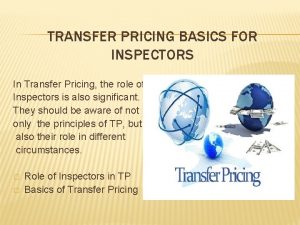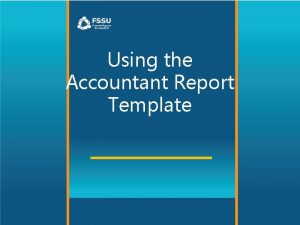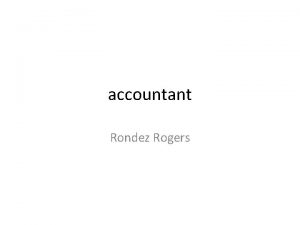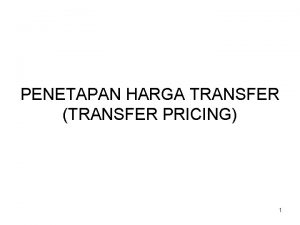TRANSFER PRICING ISSUES CMA S VENKANNA COST ACCOUNTANT







































- Slides: 39

TRANSFER PRICING ISSUES CMA S VENKANNA COST ACCOUNTANT

Background of TP � The regulations govern the prices between inter company transactions within the multinational companies. � Cross Border Transactions – between one country to another � Relating to transfer of goods, intangibles and services. � How much the MNCs pays tax to the country. � Through manipulated prices, the MNCs pays lesser tax to the country. TP results substantial increase in tax revenue and penalties. �

Impact of not adopting Arm’s Length Price � � � Results in additional income, interest and penalties Results in Double Taxation Problem. No refund of tax already paid in other countries. Long time litigations through tax audits by the department. If the MNCs does not apply normal transaction prices which are internationally applicable, and does not reflect arm’s length principle, it results it mis-pricing. The department may view this as tax avoidance.

International Transactions vis-à-vis TP � � All International Transactions does not involve determination of ALP Conditions � 1. � 2. � 3. Entities should be AEs Transactions between AEs If the Transaction Value is normal – no TP If the Transaction Value is not normal – Then Apply TP Rules � 4. Determine ALP � 5. Apply ALP and Determine the Revised Income – Sec. 92 Computation � 6. Determine the Additional Tax Liability in India

Deemed AEs Deemed AE Management Capital with Voting Power Control

Test for AE � A of US holds 30% Equity Shares of B India. And B are AEs. � Exceeds � � 26% holding with voting power. A US holds 30% Equity Shares of B India. A also holds 30% equity shares of C Japan. A B and C are AEs. Uniliver USA holds 5% Shares in Univer India. The book value of assets is Rs. 150 crores. Uniliver extends loan of Rs. 100 crores to Uniliver India. Both are AEs. Loan extended exceeds 51% of book value.

Influence � ABC India manufacture ready made garments. RMs required Rs. 950 crores. The yarn of Rs. 900 crores is procured from DEF USA. The price is influenced by DEF. Both ABC India and DEF USA are AEs. � X India sells goods to Y USA. X India also sells goods to Z UK. The prices are influenced by Y USA for the goods supplied to Z UK. � X, Y and Z are regarded as AEs.

Management � � � More than half of directors of the Board appointed by other company. A company appointed 1 ED of B ltd. A and B are AEs. ABC is an HUF in India. The members of HUF controls an entity outside India. ABC and Entity outside is AE.

International Transactions Between AEs. � Supply or Procurement of Goods � Acquiring or selling intangibles. Ex. Technical Know, etc. � Providing or Receiving Services

Intangibles � � � � Marketing Rights Technology Data Processing Engineering Contract Humand Methods and Systems Licence

ALP Methods � � � � Comparable Uncontrolled Price Method (CUP) Resale Price Method (RSM) Cost Plus Method (CPM) Profit Split Method (PSM) Transactional Net Margin Method (TNMM) Such other method – Rule 10 AB Prescribed by Board (CBDT) How to Select the Method: � � � Nature of Transaction Type of AE Relevant Factors and Circumstances Reliable Data Comparability

Alp – Tolerance Notified by Government � If the Variation between ALP and Actual Price exceeds the Tolerance Limit, then actual price is deemed to be ALP � 1% for whole sale trading � 3% for other cases Wholesale Trading – International Transaction Purchase cost of FG is 80% or more of the total cost

Example – Selection of method for ALP Sl. No. Particulars Case - 1 Case - 2 Case - 3 1 Transaction Price 2, 300 1, 900 2, 030 2 ALP computed 2, 000 3 Difference 300 100 30 4 3% of Transaction Price 69 57 60. 90 5 Observation Sl. No. 3 > Sl. No. 4 Sl. No. 3 < Sl. No. 4 6 ALP 2000 2030 7 Action of AO Addition to the extent of Rs. 300 If ALP applied, it reduces the profits. Hence No Recomputation No Adjustment is required

Example 1 - Practical Problem on ALP - CUP � M Ltd. , an Indian Company supplies Computer Parts to M Inc. USA, the parent company of M Ltd. , India. �M � � Ltd. , India and M Inc. USA are related parties In the Financial Year 2019 -20, The company also supplies identical product to another company in USA, viz. , N USA an unrelated Company. Transactions: � The price of a product is US$ 450 (FOB) to M Ltd. , USA � The price of the same product to another unrelated company is US$ 700 (CIF) � Insurance and Freight cost US $ 200.

continue � M Ltd. , extends credit period of 1 month to M Inc. USA � The cost of Credit is 12% p. a. � Sales to N USA is on Cash Basis M Ltd. Gives 6 months warrant to N Ltd. Cost of Warrant is US$50 per unit. � How to compute ALP �

ALP � Presumptions �M Ltd. India supplies Identical Product to two companies in same country � One is AE and the other is Unrelated. � All parameters are matching � Hence the transactions between M Ltd. , India and N USA forms Comparable Uncontrolled Transactions Apply the same Parameters to M Inc. USA Comparison Statement

Transaction Differences Factor Comparable Uncontrolled Transaction with N Ltd. USA International Transaction with M Inc. USA Remarks Price CIF FOB Freight and Insurance expenses $200 per unit Credit No Credit One month Credit Cost 12% p. a. Warranty Six Months No Warranty Cost $50 per unit

ALP Particulars Price per Unit of product exported to USA Add: Cost of Credit = 12% = 1% per month Less: Cost of Insurance and Freight Cost of Warrant ALP Note: Price charged is less than ALP to M Inc. USA (450) $ 7 is added to the Income of M Ltd. , India and accordingly the income will be recomputed by AO Amount in $ 700 7 -200 -50 457

Example 2 - RSM � P Ltd. , USA supplies Product A to its wholly owned subsidiary P India Ltd. , India. The product is supplied at INR 2, 000 per piece. P India Ltd. , incurs INR 10 for marketing per piece. And sells at INR 3, 000 per piece. P India also imports from S Ltd. , Singapore for INR 1, 500 per piece. The marketing costs is INR 5 per piece and it is sold for INR 2, 000 per piece. � ALP to be computed under which method

ALP Method to be applied � P India purchases the product from two companies � USA and Singapore P India undertakes only Marketing in India � Hence the suitable method shall be Resale Price Method (RSM) First : Determination of Margin on Uncontrolled Transaction which is Comparable: Sale Price INR 2, 000 Less: Purchase Price INR 1, 500 Gross Margin INR 500 Gross Margin Percentage 25% �

ALP � � There is no other related differences between comparable and uncontrollable transaction. Hence no adjustment needed. ALP Sl. No Particulars Rs. 1 Sale Price of P Ltd. , USA 2 Apply ALP Gross Margin at 25% 3 ALP of Related Party 2, 250 4 Related Party Purchase Price 2, 000 3, 000 750 ALP should not be adopted since the income of P India gets reduced. Actual transaction price is less than ALP.

Example 3 - CPM � � � Bosch Ltd. , India is a financial BPO arm of Bosch Inc. , Germany. The BPO bills Bosch Inc. , at $ 20, 000 per month. The basis for billing is the man hours spent on each work. Bosch Ltd. , India also provides the same service to SA Inc. , South Africa and bills at $18, 000 per month. The Direct Cost of services per hour for Bosch Ltd. , India works out to $ 500 and Indirect Cost of services works out to $2, 000 per hour. Bosch, India works in 2 shifts and number of days in month is 30 Consists of 7 hours work for Bosch, Germany and 6 hours work for SA, South Africa respectively. Whether the transactions at ALP

� � Bosch Ltd. , India provides services for different clients. Consumes different man-hours Determine the Gross Margins realized. Cost Plus Method is suitable as gross margin can be identified taking into account the man-hours spent. Particulars for Uncontrolled transaction) SA, South Africa Direct Cost of Service ($500 x 6 x 30) Indirect Cost of Service ($2000 x 6 x 30) Total Cost Gross Margin (Billing Price-Total Cost)(18, 0004, 50, 000) Gross Margin to Cost (13, 50, 000/4, 50, 000 x 100) Rs. 90, 000 3, 60, 000 4, 50, 000 13, 50, 000 300%

ALP Sl. No. Particulars (1) (2) Cost of Bosch Inc. , Germany a) Direct Cost ($500 x 7 x 30) b) Indirect Cost ($2000 x 7 x 30) Total Costs (3) Apply ALP Gross Margin of 300% (5, 25, 000 x 3) 15, 75, 000 (4) ALP of Related Party Transactions ((2) + (3) 21, 000 (5) Actual Related Party Transaction Price 20, 000 Price Realized from the Transaction with AE is less than the Price in Unrelated Transaction. Hence ALP should be considered. Therefore Bosch Ltd. , India has to offer the difference of Rs. 1, 000 for Taxation Rs. 1, 05, 000 4, 20, 000 5, 25, 000

Example 4 - PSM � SG Ltd. , India exports semi finished goods to its parent company SG Inc. , USA. Export Price $200 per unit to the US Company (Freight and Insurance $75 per unit incurred separately. The cost of the product works out to $125 per unit on import. SG Inc. , USA completes the product and markets the same at $500 per unit. The finishing and marketing cost @$100 per unit. � It is a single product captively consumed and ultimately sold by the AE in USA. The profit realized is only one. Hence split the margin among the related parties is suitable. Hence Profit Split Method is adopted

Workings Particulars Sale Price Less: Costs • Manufacturing Costs of SG Imported • Finishing and Marketing Costs Amount in $ 500 125 100 225 275 75 200 • Less: Freight and Insurance Costs • Net Profit Apportionment of Profit based Direct Costs SG India (200 x 125/225) SG Inc. , USA (200 x 100/225) Total Profit Amt in $ 111 89 200

Example 5 - TNMM � M Ltd. , India exports carved furniture to its Holding Company M Inc. , Canada. The sale price per furniture set is Canadian $ 2, 500 Million The direct and Indirect costs amount to Canadian $ 1, 750. The furniture Industry in India, comparable companies earns total revenue of Canadian $ 3, 750 Million. The industry average of total expenses of similar companies works out to 85%. � ALP to be determined

Analysis � � � M Ltd. , India exports carved furniture to its parent Company. No other comparable uncontrolled transaction available in the Company. The assessee company is in furniture industry, the industry averages shall be taken for comparison. The margin of the Company and Margin of the Industry is compared to determine ALP. The method applied is Net Margins, i. e. , Transactional Net Margin Method (TNMM)

Computation Net Margin of M Ltd. , India Sales made by M Ltd. Less: Direct and Indirect Costs Net Margin to Cost Net Margin of the Industry Turnover Less: Total Expenses- 3, 750 x 85% Net Margin to Cost Computation of Arm’s Length Sales Revenue Amt in Canadian $ Million 2, 500 1, 750 43% Amt in Canadian $ Million 3, 750 3, 188 562 18% Amt in Canadian $ Million Total Expenses incurred by M Ltd. , India 1, 750 Arm’s Length Sales Revenue Applying ALP Net Margin on Cost incurred = 1, 750 x 118/100) 2, 065 Actual Sales Revenue 2, 500

Note � AS THE SALES REVENUE REALISED FROM PARENT COMPANY, CANADA IS MORE THAN THE ARM’S LENGTH SALES REVENUE COMPUTED TAKING INTO ACCOUNT THE INDUSTRY NET MARGIN INDICATOR, THE INTERNATIONAL TRANSACTION SHALL BE REGARDED AS ADHERING WITH ARM’S LENGTH PRINCIPLE

TP – Issues in India � � Comparability Analysis Comparability analysis is the key to determining the arm’s length price of an international transaction. However, increased market volatility and increased complexity in international transactions have thrown open serious challenges to comparability analysis and determination of the arm’s length price. Identification of risks and of the party which bears such risks are important steps in comparability analysis

ALP on Intangibles � � Transfer pricing of intangibles has been a difficult area of work for tax administrations across the world. The situation has been same for the Indian tax administration. The pace of growth of the intangible economy has opened up new challenges to the arm’s length principle. Transactions involving intangible assets are difficult to evaluate for the following reasons: Ø intangibles are rarely traded in the external market and it is very difficult to find comparables in the public domain; Ø intangibles are often transferred bundled along with tangible assets;

� � Serious difficulties have been encountered in determining the rate of royalty charged for the use of brands and trademarks in certain cases. Indian subsidiaries using the technical know-how of their parent company have incurred significant expenditure to customize such know-how and to enhance its value by their R&D efforts. Costs of activities, such as R&D activities which have contributed to enhancing the value of the know-how owned by the parent company, are generally considered by the Indian transfer pricing administration while determining the arm’s length price of royalties for the use of technical know-how.

Issues and challenges � Functional analysis – each enterprise to identify � R&D � Design � Engineering � Marketing and distribution function � Management � Financial Risks and market risks � Contractual terms � Market Conditions � Geographical Issues � Government and Regulations

Strategies � Business Use of data of different years previous year vs. current year MNC losses Set offs within the MNC Group Companies � Use of Customs Valuation under WTO Guidelines � � Both for imports and exports

Selection of TP Methods � � � No one method is generally applicable to different situations. Ultimately computation of ALP is a highly complex task Requires huge amount of efforts Co-operation from the Tax Payer and Tax Authorities regarding documentation, ground work, analysis and research. The adjustments made by the transfer pricing officers (TPOs) have been subject to judicial reviews in India and although the matter is still to be finally adjudicated by the Supreme Court and the decisions of the High Courts and Tribunals. The Indian tax administration has been applying these principles to make adjustments but it is apparent that the process is complex, fact intensive and not free from disputes. The efforts being made by the Indian tax authorities to bring uniformity in approach and the expected judicial verdict from the Indian Supreme Court are likely to bring more clarity in the process.

Legal Issues � � � A comprehensive dispute resolution mechanism is available to the taxpayers in India facing transfer pricing adjustments. As a part of the legal process in all cases, the Assessing Officer (AO) incorporates the order of the Transfer Pricing Officer (TPO) in his order and issues a draft order to the taxpayer. The taxpayer has the option to file an objection against the draft order before the Dispute Resolution Panel (DRP) which is a panel comprising three Commissioners of Income-tax. The AO issues a final order in compliance with the DRP’s directions. At present, the direction of the DRP is final for the tax administration and it cannot appeal further against the DRP’s order. The taxpayer can challenge the direction of the DRP in appellate forums.

Steps by Government � � � Government of India has taken several steps to reduce litigation and the time needed to resolve tax disputes. Some of the steps taken in this direction are the following: introduction of the ‘Range’ concept in the Transfer Pricing Law along with the use of multiple-year data; Ø use of the Mutual Agreement Procedure (MAP) for speedier resolution of pending cases; Ø introduction of Advance Pricing Agreement (APA) provisions in the law; and Ø introduction of Safe Harbour provisions in the transfer pricing law.

THANK YOU Behind Every Successful Business Decision, There Is Always A CMA
 Cynthia cooper worldcom
Cynthia cooper worldcom Cynthia cooper (accountant)
Cynthia cooper (accountant) Acerage salary
Acerage salary What is fund accounting
What is fund accounting Types of responsibility accounting
Types of responsibility accounting Famous forensic accounting cases
Famous forensic accounting cases Junior accountant career path
Junior accountant career path Heart of darkness deaths
Heart of darkness deaths Lcmha
Lcmha Clare sandland
Clare sandland Certified management accountant
Certified management accountant Strategic accountant
Strategic accountant Ian devine accountant
Ian devine accountant Term and reversion valuation
Term and reversion valuation Ethisch dilemma accountant voorbeeld
Ethisch dilemma accountant voorbeeld Estonia accountant
Estonia accountant Transfer price meaning
Transfer price meaning Transfer pricing example
Transfer pricing example Transfer pricing examples
Transfer pricing examples Types of responsibility accounting
Types of responsibility accounting Transfer pricing example
Transfer pricing example Importance of transfer pricing
Importance of transfer pricing Decentralization and transfer pricing ppt
Decentralization and transfer pricing ppt Roi vs roe
Roi vs roe Pricing methods in managerial economics
Pricing methods in managerial economics Multi-state transfer pricing analysis
Multi-state transfer pricing analysis Oracle transfer pricing
Oracle transfer pricing Oecd business restructuring
Oecd business restructuring Transfer pricing
Transfer pricing Global transfer pricing survey
Global transfer pricing survey Wu transfer pricing center
Wu transfer pricing center Pengertian transfer pricing
Pengertian transfer pricing Transfer pricing in managerial economics
Transfer pricing in managerial economics Cma usoap
Cma usoap Usoap cma
Usoap cma Toolkit cma
Toolkit cma Cma cgm christopher columbus
Cma cgm christopher columbus Managerial accounting
Managerial accounting Perbedaan cma dan cpma
Perbedaan cma dan cpma Uf-cma
Uf-cma
